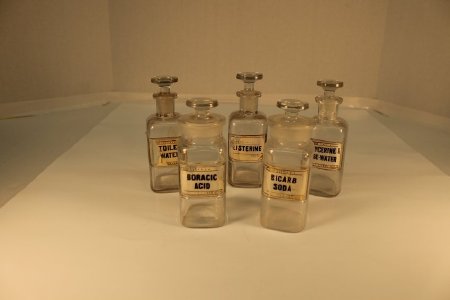Object ID Number:
PH107
Object Name:
Bottles
Type:
Shop Furniture
Manufactured from:
1825
Manufactured to:
1875
Description / History:
In this collection there are five machine blown glass bottles each with individualized labels. These labels appear to be hand–painted directly onto the glass with a white background and black font with a gold border and design to specialize the labels. Three glass bottles (A, B, C) have a very narrow neck with a small top; while the two other bottles (D, E) have a wider neck with a more flat, large top. The bottles are empty. Below is a brief description of each of the bottles and the contents that would have originally appeared in each of them.
A: Bottle A has a label reading "Listerine." In the 19th century Listerine was used as a surgical antiseptic. Later, a more distilled version was used as a floor cleaner and then as a cure for gonorrhea. In the 1920s, however, they realized Listerine could be used to cure bad breath and is still being used today as a mouthwash.
B: Bottle B has a label reading "Glycerine & Rose–Water." Glycerin and rose water have been combined together to help with skin rashes, itchiness, and redness and also as an aftershave or face toner. It is still used as a moisturizer today.
C: Bottle C has a label reading "Toilet Water." Toilet water is used as a dilute, very weak perfume typically used in France called "Eau de toliette." It is still a popular term used today.
D: Bottle D has a label reading "Boracic Acid." Boracic acid was originally used as an antiseptic. Today, we also use boracic acid as an acne treatment, an athlete foot cure, a pH balancer, and ear infection treatment when used with alcohol.
E: Bottle E has a label reading "Bicarb Soda," short for bicarbonate soda. Bicarbonate soda is used and has been used to reduce stomach acid for short–term relief.
A: Bottle A has a label reading "Listerine." In the 19th century Listerine was used as a surgical antiseptic. Later, a more distilled version was used as a floor cleaner and then as a cure for gonorrhea. In the 1920s, however, they realized Listerine could be used to cure bad breath and is still being used today as a mouthwash.
B: Bottle B has a label reading "Glycerine & Rose–Water." Glycerin and rose water have been combined together to help with skin rashes, itchiness, and redness and also as an aftershave or face toner. It is still used as a moisturizer today.
C: Bottle C has a label reading "Toilet Water." Toilet water is used as a dilute, very weak perfume typically used in France called "Eau de toliette." It is still a popular term used today.
D: Bottle D has a label reading "Boracic Acid." Boracic acid was originally used as an antiseptic. Today, we also use boracic acid as an acne treatment, an athlete foot cure, a pH balancer, and ear infection treatment when used with alcohol.
E: Bottle E has a label reading "Bicarb Soda," short for bicarbonate soda. Bicarbonate soda is used and has been used to reduce stomach acid for short–term relief.
Dimensions:
H–5.5 W–1.75 L–1.75 inches
